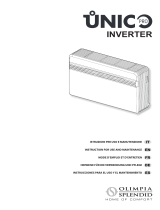
30
ENGLISH
To prevent the creation of large amounts of dust and rubble due to drilling, the core borer can be fitted with a vacuum system applied
by means of suction cups to the drilling zone. Our Service Department can give you all necessary information to enable you to
find these devices.
To drill the holes, proceed as follows:
Fasten the drilling template to the wall leaving the necessary space from the ceiling, floor and side walls as shown on the template
that may be fixed using adhesive tape.
Use a small drill or punch to mark, with extreme care, the exact centre of each of the holes to be drilled.
Using a core boring head measuring at least 162 mm to drill the two holes for entry and exit of the air.
WARNING: drill the foregoing holes tilted slightly downwards to prevent water from being fed back through the
ducts (fig. 5).
Most of the removed material is expelled outwards, therefore make sure that it does not hit any person or object when it falls out.
In order to avoid as much as possible outer plaster breaking, it is necessary to proceed carefully with the last part of hole execution,
decreasing pressure on core borers.
Next, drill the holes for anchoring the fastening brackets to the wall using as a first option the 4 holes on the ends of the bracket
as shown on the drilling template.
If the wall is not very solid, it is advisable to use some extra anchor bolts.
As you can see, the bracket can be fastened in a number of different ways and positions. The majority of the weight of the appliance
is to the right side so ensure that fixing is more secure on this side.The anchor bolts provided require holes with a diameter of
10 mm.
In any case, the wall should be inspected carefully to determine the best possible anchorage and type of bolts suitable for particular
situations.
WARNING: the manufacturer will not be held liable for any underestimates made in the structural consistency of the anchor prepared
by the installer.
Therefore, pay utmost attention to the foregoing operation that could cause serious injury/damage to people/property if carried
out incorrectly.
When installing models equipped with heating pump, if no condensate discharge was built into the wall (see paragraph 2.3.2),
in order to drain the condensate it will be necessary to drill a hole through the wall in the position shown on the template.
2.3.3 Preparing the condensate discharge
As far as machines equipped with a heating pump are concerned, connect the unit to the condensate discharge pipe (supplied)
by coupling it with the specific vent (fig. 6 ref. A) that is on the back of the machine (remove cap B). When the max level is reached,
a solenoid valve ensures the condensate will flow out from the internal tray. For cold-only machines, connect the condensate
discharge pipe if you intend running the unit at low outdoor temperatures (lower than 23°C).
Since condensate drains by gravity, there must be a minimum slope of at least 3% at every point of the discharge line. Use a rigid
or flexible tube having an inside diameter of at least 16 mm.
If the line empties into a sewerage system, install a siphon before the point in which the pipe reaches the main discharge, at least
300 mm below the inlet from the unit (fig. 6).
If the drainpipe drains into a vessel (tank or other container), this container should not be sealed and the drainpipe should
not remain immersed in the water (see fig. 7).
The hole through which the condensate pipe passes should always slope towards the outside (see fig. 8).
The exact position in which to place the pipe inlet, as compared to the machine, is shown on the drilling template.
CAUTION: make sure, in this case, that the water expelled outward does not damage or disturb persons or
property. During the winter this type of drainage may cause sheets of ice to form.
When the condensate drainage is fitted, pay much attention not to compress the rubber hose.
2.3.4 Assembly of the air ducts and external grids
After having drilled the holes, insert the plastic sheet supplied with the conditioner into them.
Since the sheet was made for 202 mm holes, you will have to cut off 130 mm from the long side of the sheet for the 162 mm holes.
The length of the sheets must be 65 mm less than the thickness of the wall.
Roll the sheet and insert it into the hole (fig. 9), paying attention to the splicing line (fig. 9 ref. A), which must always face
upwards.
Use an ordinary cutter for the foregoing operation (fig. 9).
To position the external grids, proceed as follows:
- Apply the seal (fig. 10 ref. B) to the wall flange (fig. 10 ref. A), ensuring it lines up with the outer edge of the flange as indicated
in the figure.
- Fix the two flanges using 2 pegs having a diameter of 6 and check that the two fixing holes are horizontal.
- Fit the small eyelet of the spring, with the long stem, on the cap pin (on both components) (fig. 11).
- Insert the two caps (with spring), on the front part of the external grid, on its two housings, pulling until it clicks (fig. 12) and
2
Downloaded from AC-Manual.com Manuals



























